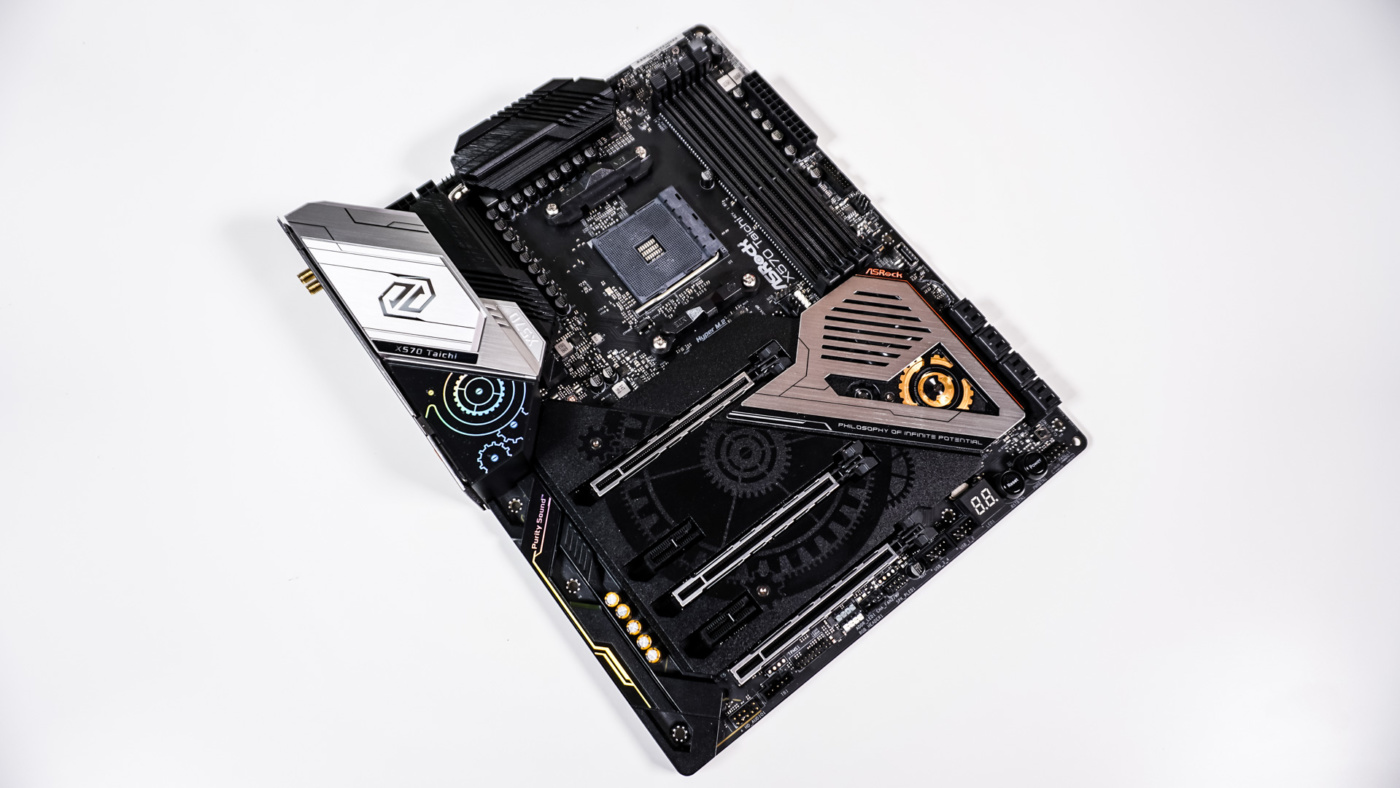ASRock X570 Taichi Motherboard
As I said the X570 Taichi is the best-looking Taichi board that we’ve seen from ASRock! It has an all black PCB with silver and black accents on the heatsinks. There are lots of clockwork designs on the board too, which we will get into in just a little bit.
Starting at the CPU socket we of course have AMD’s AM4 socket. X570 motherboard will support both 2nd and 3rd generation Ryzen processors. The X570 Taichi features a 14 phase (6 x 2) + (1 x 2) power design that makes use of 60A power chokes. The power delivery components are covered by two large heatsinks, which are connected by a heatpipe.


Towards the top corner of the board you’ll find an 8-pin EPS connector, extra 4-pin power connector and a 4-pin fan header.
Moving over to the memory slots there are four DDR4 DIMM slots, which support up to DDR4-4666+ (OC) memory on Ryzen 3000 series processors. These slots are not metal reinforced, but not have locks on the bottom, which would make swapping out your memory with a graphics card installed very easy. Right above the memory slots you’ll find your CPU fan and CPU optional fan headers. Along the edge of the board is a 24-pin ATX power connection, a USB 3.2 Gen 1 header, 4-pin fan header, and an internal USB 3.2 gen 2 connector.
Moving down the board there are eight SATA 6GB/s ports. These are of course controlled by the X570 chipset and offer RAID 0, 1, and 10 modes.
At the bottom of the board you are going to find the rest of your headers and connections, from left to right include your HD audio headers, Thunderbolt header, TPM header, 3-pin addressable RGB header, 4-pin standard RGB header, 4-pin fan header, two USB 2.0 headers, a POST code display, power and reset buttons, front panel headers and a clear CMOS button.
The bottom half of the board has one very large heatsink on it. This heatsink covers the three M.2 slots and connects with the chipset heatsink. It is actually one single piece, which means if you want to install an M.2 drive you have the fully remove it. It do like the clockwork designs on the heatsink and the gears embedded in the part that covers the chipset. It would have been really cool if these moved when you turned your system on, but sadly they do not.


Before we remove this heatsink lets take a look at expansion slots. You have three PCI-Express 4.0 x16 slots and two x1 slots. Remember these will only run at PCI-Express 4.0 with a Ryzen 3000 series CPU. With a single card installed the top slot will run at x16 speeds, but if you install two cards they will run at x8 speeds. All three of the x16 slots feature ASRock’s Steel Slot which provides better stability for heavier graphics cards.


The large heatsink on the bottom half of the board is held in place by three Torx screws. ASRock does provide a small screwdriver to remove them. With the the heatsink removed we can see our three PCI-Express 4.0 M.2 slots. The top two are M.2 2280 which will support M.2 SSDs up to 80 mm, while the bottom is M.2 22110 with support for M.2 SSDs up to 110 mm. With the heatsink removed we can also take a look at the active fan on the chipset heatsink. Most X570 motherboards will have an active fan on the chipset as the X570 chipset uses 3 times as much power as the previous X470 chipset.


When it comes to audio ASRock is using their Purity Sound 4 solution which makes use of the latest Realtek ALC1220 audio codec and an 120dB SNR DAC. There are also individual PCB layers for the right and left audio channels. Most of the audio components are covered, but we can spot the audio capacitors on the board.
Coming over to the rear I/O it has a nice cover on it, which says X570 Taichi and will light up with RGB lighting (you’ll see that in a little bit). The rear I/O also has an integrated shield, which I love to see. As far as connections and buttons on the rear I/O we have a BIOS flashback button, 2 antenna ports, a combination PS/2 port, two USB 3.2 gen 1 ports, a small clear CMOS button, HDMI, Gigabit Ethernet, for more USB 3.2 gen 1 ports, two USB 3.2 gen 2 ports (1x Type-A, 1x Type-C), and your audio connections. The WiFi on the board is powered by an Intel 802.11ax adapter. USB BIOS flashback allows you to flash your BIOS with only a power supply connected to your motherboard. No CPU, RAM, or other components are needed.










